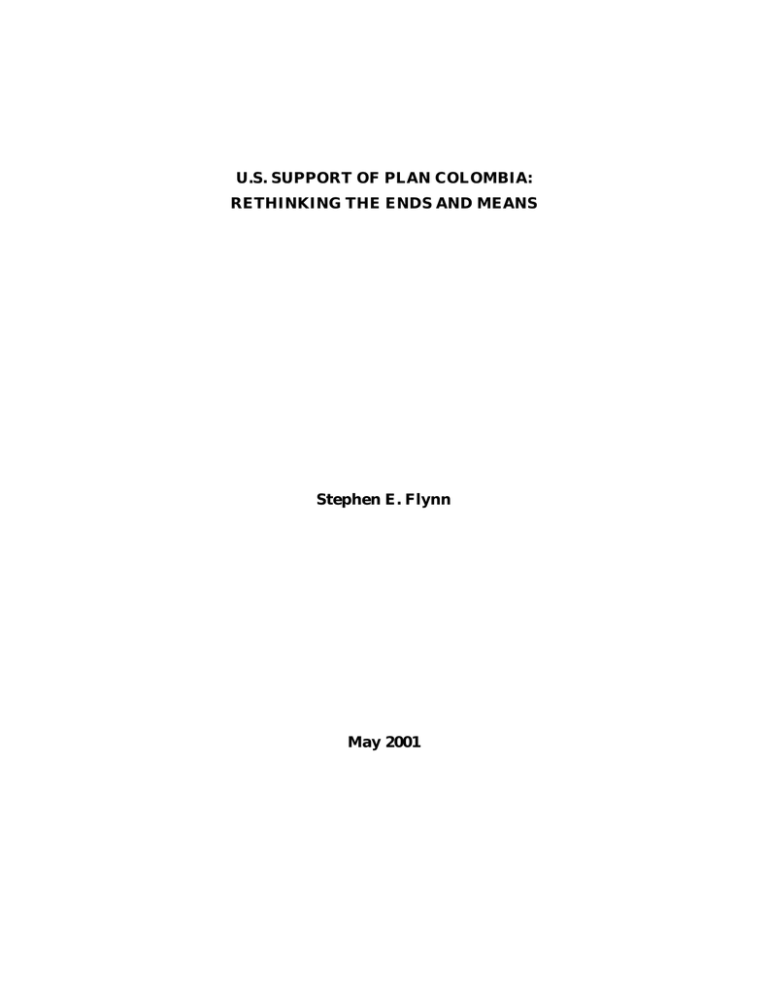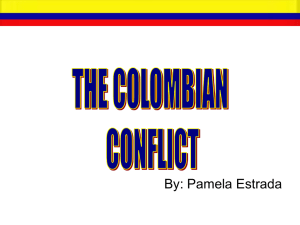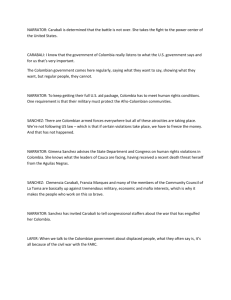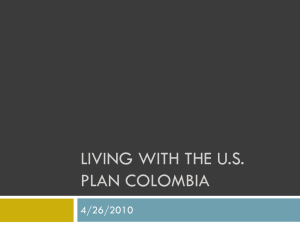U.S. SUPPORT OF PLAN COLOMBIA: RETHINKING THE ENDS AND MEANS May 2001
advertisement

U.S. SUPPORT OF PLAN COLOMBIA: RETHINKING THE ENDS AND MEANS Stephen E. Flynn May 2001 ***** The views expressed in this report are those of the author and do not necessarily reflect the official policy or position of the Department of the Army, the Department of Defense, or the U.S. Government. This report is cleared for public release; distribution is unlimited. ***** Comments pertaining to this report are invited and should be forwarded to: Director, Strategic Studies Institute, U.S. Army War College, 122 Forbes Ave., Carlisle, PA 17013-5244. Copies of this report may be obtained from the Publications and Production Office by calling commercial (717) 245-4133, FAX (717) 245-3820, or via the Internet at Rita.Rummel@carlisle.army.mil. ***** Most 1993, 1994, and all later Strategic Studies Institute (SSI) monographs are available on the SSI Homepage for electronic dissemination. SSI’s Homepage address is: http://carlisle-www.army. mil/usassi/welcome.htm ***** The Strategic Studies Institute publishes a monthly e-mail newsletter to update the national security community on the research of our analysts, recent and forthcoming publications, and upcoming conferences sponsored by the Institute. Each newsletter also provides a strategic commentary by one of our research analysts. If you are interested in receiving this newsletter, please let us know by e-mail at outreach@carlisle.army.mil or by calling (717) 245-3133. ISBN 1-58487-052-4 ii FOREWORD This is one of the monographs in the series from the February 2001 conference on Plan Colombia cosponsored by the Strategic Studies Institute of the U.S. Army War College and The Dante B. Fascell North-South Center of the University of Miami. In this short essay, Stephen E. Flynn provides an intended counterpoint to Dr. Gabriel Marcella’s lead-off monograph in which he argues that Plan Colombia is a brilliantly conceived grand strategy for democratization and national security. Dr. Flynn argues that the U.S. emphasis on drug control in its support of Plan Colombia is misguided and akin to prescribing an antibiotic regime to combat a disease not caused by bacteria or similar micro-organisms. The illegal drug industry in Colombia is not the cause of that country’s fragile socio-political system, but a symptom of and a contributor to the fragility of the Colombian state. Continuing the analogy, Flynn argues that U.S. and Colombian emphasis on combating illicit drug cultivation and trafficking leads to several undesirable side effects. The Strategic Studies Institute is pleased to offer this monograph as part of the ongoing clarification of the uncertainty and confusion that permeate the national security debate involving U.S. policy in Colombia and the implementation of Plan Colombia. DOUGLAS C. LOVELACE, JR. Director Strategic Studies Institute iii PREFACE Stephen Flynn’s credibility on the issue of anti-drug policy is hard to match. Not only is he a respected scholar and a broad strategic thinker, but as a commander in the U.S. Coast Guard, he knows the problems directly from the front lines. For those reasons, this monograph, even more than the popular film “Traffic,” is profoundly disquieting. Flynn tells us, among another things, that the policy that this country has been pursuing in Colombia at a huge cost is largely futile. If present U.S. antidrug efforts have been sold to the American public as leading to reduced amounts of drugs available on the street, such a suggestion, he tells us, is “either naive or duplicitous . . .” What is even worse, according to Flynn, is that if the drug trade in Colombia is seriously disrupted, it will simply be pushed to Mexico. The result would be “disastrous,” with Mexico being adjacent to the United States, and with a better organized operation than presently exists in Colombia. We live in a world of porous borders in which free trade and open-market capitalism are the order of the day. Millions of people, automobiles, trucks, and maritime containers enter this country, as Flynn points out with some remarkable statistics. What is to be done? Flynn offers serious alternatives. The most important and most obvious is to deal differently with this country’s 5 million addicts and frequent users, who consume the overwhelming majority of drugs. How? Simply “invest in long-term treatment,” i.e., rehabilitation, which is not now the top priority. He also advocates a costly and ambitious program of transparency and enforcement in cross-border activities. v Add to that a program of spotlighting businesses which operate outside of established codes and attacking transnational crime more efficiently through effective international cooperation, which includes the press, judicial systems, and government officials on a broad scale. If this country is unwilling to make all these investments, Flynn concludes, it should recognize that “a failed prohibitionary approach to drug control does more harm than good for it ends up serving the interests of organized crime . . .” What is he telling us? Flynn does not go further into such issues as “lifting the prohibitions.” They will be the subject of national debate, however, as the failures of present policy are more clearly understood. There could be a number of alternatives. One might be this: do not legalize or even decriminalize illegal drug sales, but re-focus massive expenditures on education and treatment. Then deal with the 5 million addicts as public health patients, not criminals, by offering them a prescribed drug dosage with immediate treatment (voluntary) if they will accept it. If each addict spends an average of, hypothetically, $15,000 per year, then removal of the addicts from the market would remove $75 billion from it, delivering potentially a knockout blow to illegal drug sales in this country. Flynn’s monograph is a great starting point to wake this country’s leaders to realistic analysis and imaginative changes of program and policy. Let the debate begin soon. Ambler H. Moss, Jr. Director The Dante B. Fascell North-South Center University of Miami vi BIOGRAPHICAL SKETCH OF THE AUTHOR STEPHEN E. FLYNN is a senior fellow with the National Security Studies Program at the Council on Foreign Relations, New York. He is also a Commander in the U.S. Coast Guard as well as Associate Professor of International Relations and Director of the Center for Advanced Studies at the U.S. Coast Guard Academy. Currently he directs a national study group at the Council on Foreign Relations on “Globalization and the Future of Border Control.” From 1991 to 1992, Dr. Flynn was a guest scholar in the Foreign Policy Studies Program at the Brookings Institution. From 1993 to 1994, he was an Annenberg Scholar-in-Residence at the University of Pennsylvania. A 1982 graduate of the U.S. Coast Guard Academy, he served twice in command at sea. He served in the White House Military Office during the first Bush Administration and as Director for Global Issues on the National Security Council staff during the Clinton Administration. Dr. Flynn is author of several articles and book chapters on border control, the illicit drug trade, and organized crime. Most recently, his article “Beyond Border Control” appeared in the November/December 2000 issue of Foreign Affairs. He received an M.A.L.D. in 1990 and a Ph.D. in 1991 from the Fletcher School of Law and Diplomacy at Tufts University. The views expressed in this monograph are his own and do not reflect the official positions of the U.S. government or the Council on Foreign Relations. vii U.S. SUPPORT OF PLAN COLOMBIA: RETHINKING THE ENDS AND MEANS Introduction. The development of antibiotics is one of the great medical breakthroughs of the 20th century. But too often antibiotics are being prescribed for ailments they are powerless to combat, or patients are not taking their antibiotics as directed. The result has been a worrisome growth of drug-resistant micro-organisms that are proving ever more costly and, in some cases, impossible to treat. There is a lesson here—the wrong or a partial cure, no matter how well-meaning the doctor or patient who embraces it—may end up making matters worse, both for the patient and the community at large. The U.S. emphasis on drug control in its support of Plan Colombia has all the ingredients of a flawed antibiotic regime. First, it relies too heavily on a diagnosis of “narco-terrorism” as what ails Colombia when there is a far more complex and deadly virus at work. Second, as much as the patient may want to get better, Colombia lacks the means to carry out the prescribed treatment. Finally, the drug trade “infection” is already mutating and promises to be a more daunting and dangerous threat to the region than the very serious military and security crisis that currently embroils Colombia. The Colombian Disease. The production and trafficking of illicit drugs are not the cause of Colombia’s fragile socio-political system—they are symptoms of and contributors to that fragility. As such, while confronting the drug trade must be part of any strategy that aims to bolster the Colombian state, it will always be insufficient. Illicit coca cultivation thrives in 1 Colombia because this country possesses most of the optimal ingredients to attract and sustain that production. As a huge country of 439,513 square miles, split by three mountain ranges, Colombia would be a difficult nation to rule under the best of circumstances. As a nation embroiled in a half-century of violent civil war where the reach of the state’s services has rarely extended beyond the major urban centers, conditions for exercising the sovereign prerogatives of the state over this huge land mass have always been marginal at best. Throughout the countryside there is no shortage of impoverished farmers to be recruited or coerced, and no shortage of guerrillas and paramilitary groups to aid and abet them in the cultivation of coca and the production of cocaine. The Colombian civil war has persisted in no small part due to the paucity of real socio-economic reforms, particularly land reform, the lack of which fuels the widespread sense of political injustice exploited by radicals and despots. The longstanding practice of resolving conflicts through violence traces its roots in part to the lack of a competent and credible criminal justice system. Finally, the ability of drug barons to reap the rewards of their illicit labors can be credited to the robust informal economy in Colombia that makes it possible to launder billions of dollars in drug profits with virtual impunity. Any plan to bolster the Colombian state that fails to seriously address these core issues is doomed to fail. U.S. Counter-Drug Assistance: A Flawed Antibiotic. The primary drivers of the drug trade are ubiquitous: they are money, self-gratification, and addiction. Thus, the drug control mandate requires that states use their coercive powers, first, to rein in the desire by some individuals to consume mind-altering drugs; and second, to undermine the market that aims to profit by satisfying those consumers. This is a daunting challenge for even a strong state, particularly if it supports free markets and respects 2 basic civil liberties. But even the most draconian state has to reckon with the fact that the drug trade is a transnational one that promises to thrive as long as there are dark corners of the international systems where traditional sovereign controls are weak or non-existent. The illicit drug supply can be cultivated wherever local enforcement bodies are too primitive or corrupt to take the actions necessary to stop the production of drug raw materials within their borders. Moving cocaine or heroin from remote production areas to distant consumers will be possible as long as drug traffickers can count on the mounting odds against success in sifting contraband from the rising tide of legitimate goods, services, and people that now wash across national borders as a result of the explosive growth of the global economy and the twin trends of liberalization and privatization. Finally, as democratization has taken root around the planet, drug consumers in places like Russia and Eastern Europe can pursue socially-proscribed activities with less risk of arrest by police authorities whose capacity to intrude into the lives of citizens has been properly reined in.1 In short, contemporary drug control must take place against a backdrop where drugs are produced, trafficked, and consumed by individuals who find borders essentially meaningless. As long as there are gaps between de jure sovereignty and de facto sovereignty, there will be no shortage of space through which the drug trade can move. Unfortunately, there is an abundance of such locales within Colombia and among the states that border it within the Andean region. Things are little better closer to home, where despite two decades of stepped-up efforts to police the Caribbean Sea and U.S. borders, there remain ample opportunities to smuggle illicit drugs into the United States. In the year 2000 alone, 477 million people, 127 million automobiles, 11.5 million trucks, and 5.8 million maritime containers entered U.S. territory.2 The United States has nearly 100,000 miles of shoreline and almost 6,000 miles of borders with its neighbors. People and goods 3 arrive daily at more than 3,700 terminals in 301 ports of entry. Intercepting within this tidal wave of commerce the requisite equivalent of 15 40-foot containers presents law enforcement with the kind of odds one expects for winning a lottery.3 Accordingly, since access into the major markets for illicit drugs is not likely to be seriously challenged, the market will inevitably adapt to a stepped-up investment in Colombia’s counter-drug efforts. Accordingly, while those efforts may help to disrupt an important source of funding for guerrillas and paramilitary groups who rule important sections of the Colombian countryside, they hold virtually no hope for reducing the amount of cocaine or heroin available on American streets. The Clinton Administration was either naïve or duplicitous to suggest otherwise. Producing a New Virulent Strain. It is easy to predict what intensified efforts to combat drug cultivation and trafficking, particularly in Putumayo, will do to the region. Already reports are rolling in documenting the spillover of kidnappings, crime, violence, and refugees into Ecuador, Venezuela, Brazil, and Panama.4 Unfortunately, none of these countries is in a position to cope with this, particularly Ecuador and Panama. Throughout this region there are few resources and little in the way of infrastructure for promoting the rule of law or advancing economic development in the areas most susceptible to the dollars and intimidation drug traffickers can bring to bear. Nowhere is there the capacity to absorb the potential for millions of refugees from Colombia’s civil war. Even if Brazilian, Venezuelan, and Ecuadorian police and soldiers are moved into the areas so as to harden the borders with southern Colombia, the costs are likely to be prohibitively high in economic and diplomatic terms. Militarizing the border regions will inevitably compromise the cross-border flow of trade and likely sour diplomatic relations among the neighboring countries. 4 Stepped-up efforts to disrupt drug trafficking activities in Colombia may also produce harmful unintended consequences. Such efforts inevitably spawn greater innovation on the part of the drug barons. The drug enforcement community often touts this result as progress since it presumably “raises the cost of doing business.”5 This may sound like a worthy objective, but it can in fact prove to be counterproductive if enforcement ends up taking out only the low-lying fruit. More specifically, if “raising costs” applies only to entry-level competitors, the result may mean that more sophisticated trafficking organizations actually benefit from enforcement activities since they can have the result of eliminating those who might otherwise threaten their market share. Enforcement-generated innovation that leads traffickers to move from traditional non-commercial smuggling activities to more sophisticated schemes involving manufacturers, commercial carriers, exporters, and financiers can also prove to be a cure worse than the disease. This is because of the corrosive effect drug money can have across the entire commercial spectrum, undermining confidence in the private sector and the regulators charged with policing it. In addition, as legitimate trade becomes increasingly contaminated with illicit narcotics, it elevates the risk that all exports will be subject to delays and added costs associated with closer inspections and destructive searches. Perhaps the most disturbing consequence of more aggressive attacks on Colombian drug traffickers is that the likely beneficiaries will be Mexican trafficking organizations. For some time Mexican traffickers have benefited from the disruption of the cocaine trade in the Caribbean that led the Colombians to seek out an alternative route to the United States via its southwest border. Successes in the early 1990s associated with the Colombian “king-pin” elimination strategy created new opportunities for Mexican narco-traffickers to get into the wholesale cocaine distribution business in the United 5 States.6 If Colombian drug supplies begin to dry up, there is little to prevent Mexican organizations from sponsoring coca production and refinement in Peru and Bolivia or elsewhere in the Andean region, emulating the example of the Colombian drug barons in the 1970s. It should require little in the way of elaboration to explain why a transfer of control over the cocaine trade to Mexican traffickers would be so disastrous. Mexico is the United States’ second largest trading partner. At just over 100 million, its population is two and one-half times that of Colombia. Arguably, its institutions may prove less resistant than those in Colombia to the corrosive threat of “plata o plomo” (silver or lead).7 Its historic movement away from a one-party state has just begun. Political power in Mexico is more decentralized, with governors possessing a great deal of autonomy. Corruption within the police forces and some elements of the military is rampant. Like Colombia, it has its own problems with insurgencies, particularly in the Chiapas. If Mexico were to become the hemisphere’s new capital of drug trade, scarring its fragile political and economic institutions in ways similar to those that have afflicted Colombia, the repercussions for U.S. domestic and regional interests would be enormous. Alternative Prescriptions. The analysis outlined above should give pause to even those minimalists who argue that the planned U.S. contribution to Plan Colombia is better than providing no assistance at all. If Colombia were an island and the drug trade had no place to go, this would undoubtedly be true. Unfortunately, Colombia cannot be isolated from the volatile region in which it sits nor can the cocaine and heroin industries be isolated within its borders. Most importantly, the only thing we can count on if Colombian trafficking organizations are dismantled is that other traffickers— most likely Mexican—will be the prime beneficiaries. Like the dangers associated with misprescribing an antibiotic, 6 placing primary emphasis on the drug control elements of Plan Colombia may have the end-result of spawning problems more daunting than the one we started with. Defeatism is not the only alternative here, but a critical stepping-off point is to acknowledge that the stakes associated with Plan Colombia are considerably higher than the Clinton Administration led the public to believe. Preventing Colombia from spinning into a free-fall and taking down some of its neighbors with it means that the United States will have to invest the resources in tackling the root causes that made the region such an attractive base for the narcotics trade. The rural population of Colombia and much of the surrounding region is unlikely to be weaned off of drug traffickers or guerrillas without fundamental political reform and economic development. It will take the equivalent of a Marshall Plan to turn the tide. Efforts to combat drug trafficking must also take a more ambitious, comprehensive, and nuanced approach. Such an approach would include four broad elements. First, we must move from rhetoric to reality in addressing demand reduction, which means we must place primary emphasis on providing adequate medical and social services for treating drug addicts. The strategic rationale for this is straightforward: of the estimated 77 million Americans who have experimented with drugs at least once in their lifetime, five million frequent drug users consumed the overwhelming majority of drugs.8 The 50 percent decline in casual use in the United States over the past decade is a very positive development. But from a drug market standpoint, the fact that there has been little change in the number of drug addicts means that this drop in recreational drug use has had virtually no effect on the overall demand for cocaine and heroin. Thanks to drug prevention programs, the cocaine industry may not be a growth business in the United States, but the demand for coca and poppies will be unchanged as long as Americans refuse to invest in long-term drug treatment. 7 Second, we need to recognize that the narcotics trade and the illicit dollars that go with it cannot be divorced from the informal economy that is burgeoning within the region and around the world. Trade fraud, tax evasion, sweatshops that thrive off underground labor, and the smuggling of legal products ranging from from VCRs to cigarettes all provide a growing haystack within which drugs and money laundering activities can hide. To a large extent, we should look at the drug trade as something akin to the dye cardiologists use to detect blockages in the circulatory system. It highlights the gaping holes in the international economic system that have facilitated the unsettling growth of what Susan Strange has called “casino capitalism.”9 If we are serious about stemming the scourge of drugs, we must get serious about closing these holes by adopting an enforceable code covering regional business, transportation and logistics, and investment regulatory codes that brings transparency in cross-border activities. Particular attention should be paid to developing meaningful and binding guidelines for trade, transshipment, and financial record-keeping. Commercial records should be transmitted electronically at or as near to the point of origin as possible so enforcement and regulatory authorities can more effectively target their inspections. Also, the Organization of American States should be tasked and resourced to regularly publish an “Accessories to Transnational Crime Report” that spotlights business institutions and individuals who routinely fail to abide by the established codes. The goal should be to shame the participants in the black economy and shine light in their corridors, thereby enhancing the risk of detection for criminals or terrorists who are attempting to capitalize on the legitimate flow of commerce to move contraband, weapons, or money. Third, we need to develop and execute a comprehensive organized crime strategy that strives to deter and disrupt the ability of criminal networks to form, corrupt governments, and prosper from their ill-gotten gains as opposed to placing primary emphasis on prosecutions.10 The 8 counter-terrorist tactics that have been developed over the past two decades provide a more promising model for how to confront organized crime than does the Colombian kingpin elimination strategy of the 1990s. There will always be a new face to fill a vacancy on the “10 Most Wanted List.” Initiatives may include establishing a designated Organized Crime Intelligence Unit within each cooperating country that is assigned the responsibility for coordinating crime intelligence collection and analysis within its borders and working with the intelligence units from the other countries. Finally, we must be mindful of the human dimension associated with any effort to work internationally in attacking a transnational challenge like the drug trade. An ongoing effort must be made to improve cultural understanding and linguistic abilities among agencies cooperating in multilateral efforts. Journalists and investigative reporters who write stories on crime and corruption, often at significant personal risk, deserve greater support from the international community. Efforts to intimidate news media professionals or to undermine a free press should be condemned in the strongest possible terms and, when government officials are involved, subject to sanctions. A common fund should be established to train journalists as well as intelligence, judicial, financial, and law enforcement representatives; and to support exchange programs. Many may see policy initiatives such as these as impractical within the current political and budgetary environment. But if such skeptics ultimately carry the day, what alternatives remain? The current situation in Colombia makes clear that one option which is unacceptable is continuing business as usual. Sticking to an approach that narrowly focuses on drug control as if it can be divorced from the wider political, economic, and social context in which it operates practically assures that drugs will continue to be widely available, and, concurrently, that the criminal organizations involved in the trade will remain 9 powerful and corrosive—they will just operate out of different locales. The only remaining logical course to pursue if we are unable to muster the political will to undertake the ambitious proposals outlined above would be to consider dismantling the prohibitionary regime. This is because, in the final analysis, a failed prohibitionary approach to drug control does more harm than good, for it ends up serving the interests of organized crime and insurgents who benefit from the trade while actually disserving the interests and the national and international community. If the United States and the global community are unprepared to repair the systemic weaknesses facilitating and motivating drug production, trafficking, and consumption, they should begin to accommodate to the disquieting reality thus revealed: namely, that widespread drug use and its harmful social consequences are an unfortunate fact of life, the inevitable byproduct of living in an open global capitalist system that promotes the values of self-indulgence and instant gratification to a far greater extent than those of community and self-sacrifice. ENDNOTES 1. Stephen E. Flynn, “The Global Drug Trade vs. The Nation State: Why the Thugs Are Winning,” in Beyond Sovereignty, ed. Mary Ann Cusimano, New York: St. Martins Press, 1999, pp. 44-66. 2. Public Affairs Office, U.S. Customs Service, Washington, DC, January 2001. 3. Based on the White House’s Office of National Drug Control Policy estimate of maximum annual cocaine availability at 376 metric tons included in its National Drug Control Strategy 1999, and the average size of a kilogram brick, 72 cubic inches. A 40-foot container could hold 55,753 kilo bricks. 4. Suzanne Timmons, “The War on Coca: How Far Will the U.S. Go?” Business Week, November 20, 2000. 5. Testimony of Barry McCaffrey, Director, Office of National Drug Control Policy, before the House Government Reform and Oversight Committee, Subcommittee on Criminal Justice, Drug Policy and 10 Human Resources, “The Drug Legalization Movement in America,” June 16, 1999. 6. Testimony of Donnie R. Marshall, Acting Administrator, Drug Enforcement Administration, before the Senate Drug Caucus on International Narcotics Control, March 21, 2000. 7. That is, officials are confronted by traffickers with the choice of accepting a bribe or being gunned down by a bullet. 8. According to the White House Office of National Drug Control Policy’s U.S. National Drug Control Strategy: 2001, there are approximately five million drug abusers who need immediate treatment. 9. See Susan Strange, Casino Capitalism, Manchester, UK: Manchester University Press, 1997. 10. In this regard, the White House publications International Crime Control Strategy, June 1998, and its International Crime Assessment, December 2000, offer a useful stepping-off point. 11 U.S. ARMY WAR COLLEGE Major General Robert R. Ivany Commandant ***** STRATEGIC STUDIES INSTITUTE Director Professor Douglas C. Lovelace, Jr. Director of Research Dr. Earl H. Tilford, Jr. Author Dr. Stephen E. Flynn Director of Publications and Production Ms. Marianne P. Cowling Publications Assistant Ms. Rita A. Rummel ***** Composition Mrs. Christine A. Williams Cover Artist Mr. James E. Kistler






